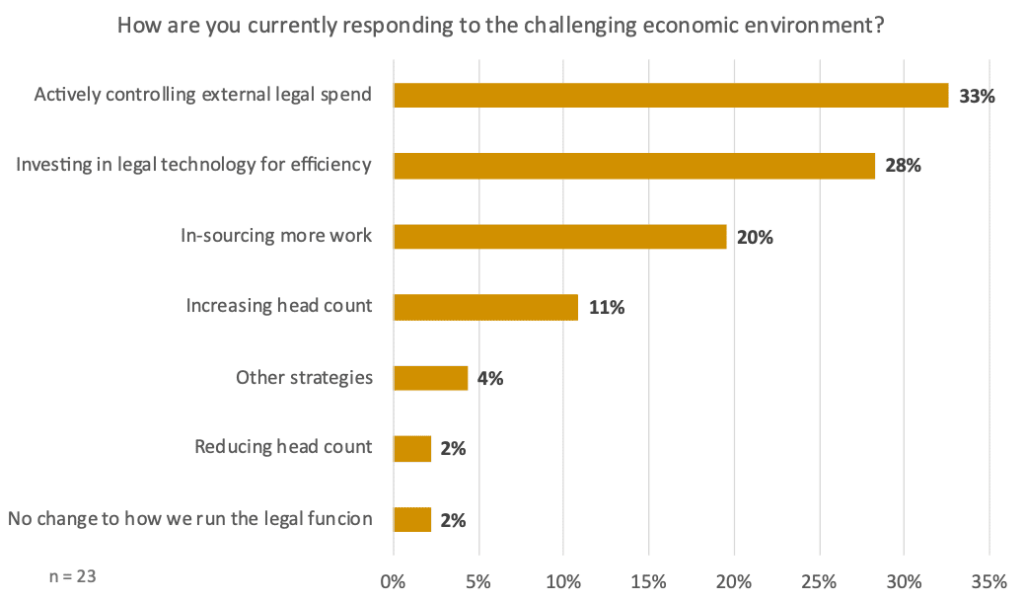Legal departments across the globe are experiencing a remarkable set of challenges: increased regulations, downward cost pressures with a looming recession, finding and retaining staff, along with a volatile and uncertain operating environment.
Monitoring spend, leveraging technology and strategic sourcing
In a recent poll of General Counsels conducted by Lawcadia and LEX360, one in three (33%) indicated that actively controlling external legal spend was the most popular strategy to respond to the current challenging economic environment. One in four is investing in legal technology for efficiency (28%), and one in five is strategically in-sourcing work (20%) and increasing headcount (11%).

The rise of metrics and data
When it comes to implementing these and other strategies, capturing and measuring data and performance helps to drive change.
According to Mo Zain Ajaz, founder of legal operations consultancy LEX360 and former General Counsel, the legal function is a system with inputs, processes, and outputs, and these can all be measured.
“General Counsels are under pressure in the current climate, and they need to demonstrate the value for their business and for their teams, and a great way of doing that is through dashboards and metrics,” said Mr Ajaz.
“Optimising and measuring each part of the legal ‘system’ enables General Counsel to make data-driven decisions, to improve workflows, and understand the health of the legal function,” he said.
Hence, capturing data, monitoring metrics and seeking to demonstrate value is quickly becoming an important agenda item for legal departments. Some General Counsel are confident that they are already tackling the data challenges in parts of their function, whilst others are just starting the journey.
External spend the focus of metrics
This recent poll highlighted that one in five (19%) General Counsels consider their legal function quite mature in capturing data and metrics on their external legal spend. A similar number (17%) consider that they are still in the early stages of working on their data and metrics.

While measuring and monitoring external legal spend, especially high-cost litigation projects, is a critical aspect of managing the legal function, capturing data and monitoring other crucial inputs, outputs and processes are also necessary.
To this end, it is also essential to consider the measurement and performance of intake and self-service, internal service delivery, contract management, law firm performance, team capacity, law firm value adds, as well as diversity and inclusion. Some areas may be strategically more important than others and can be prioritised. Regardless, careful consideration of how to capture and collate data and visualise insights in a way that is not resource-heavy will be essential.
Barriers still apparent
When considering the barriers for General Counsel and why there is still work to be done in this space, Mr Ajaz says that “getting started” and determining “what to measure” are common hurdles to overcome, as well as having good processes and the right technology.
“If you haven’t got the technology to back it, or if you haven’t got the processes to pull it together, then it becomes a cumbersome task,” he said.
As legal departments and their leaders grapple with the challenges facing them and those that may lie ahead, the demand for actionable data and insights is rising. New solutions, services and technologies will certainly help to ease these challenges.
How to implement dashboards
According to Mr Mo Zain Ajaz, every General Counsel has something they want to report, and whilst there are some metrics that may be relevant to all GCs, each organisation has different goals, risks and priorities, so dashboards must be unique to each legal department.
For legal teams that are just starting to turn their minds to reporting metrics and dashboards, Mr Ajaz has outlined some key steps to help get them on the right track.
1. Start with understanding your priorities as a General Counsel, your team and business, and your reporting to the C-suite. It could be helpful to have an independent consultant involved in this part of the process to help define what needs to be measured and reported on.
2. Identify the reports and metric sets that meet your needs. It can be helpful to have access to a set of prototype reports or template dashboards as this can provide ideas and inspiration.
3. Identify the workflows, processes, and existing data sets that can be configured to meet the reporting requirements.
4. Utilise technology solutions, such as Lawcadia, that enable dashboards to be updated automatically through the use of digital workflows.
5. Configure the workflows and dashboards and get your team on board.
Successful legal transformation and change also requires a focus on “people” (change, skills, motivation) as well as “process” and “technology”. So, it is vital to ensure that you have the right level of support, either internally or via external consultants, to assist with change management to deliver successful outcomes.
View the live event recording – The GC’s Ultimate Dashboard

